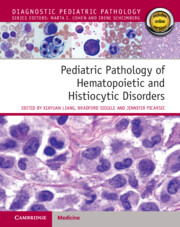Book contents
- Pediatric Pathology of Hematopoietic and Histiocytic Disorders
- Pediatric Pathology of Hematopoietic and Histiocytic Disorders
- Copyright page
- Epigraph
- Contents
- Contributors
- Section I General Hematology and Hematopathology
- Section II Non-Neoplastic Hematologic Disorders of Blood and Bone Marrow
- Section III Non-Neoplastic Disorders of Extramedullary Lymphoid Tissues
- Section IV Neoplastic Disorders of Bone Marrow
- Section V Mature Lymphoid Neoplasms
- Chapter 20 Mature B-Cell Non-Hodgkin Neoplasms
- Chapter 21 Mature T-Cell and NK-Cell Non-Hodgkin Lymphomas
- Chapter 22 Hodgkin Lymphoma
- Chapter 23 Immunodeficiency-Associated Lymphoproliferative Disorders
- Section VI Histiocytic Disorders and Neoplasms
- Index
- References
Chapter 20 - Mature B-Cell Non-Hodgkin Neoplasms
from Section V - Mature Lymphoid Neoplasms
Published online by Cambridge University Press: 25 January 2024
- Pediatric Pathology of Hematopoietic and Histiocytic Disorders
- Pediatric Pathology of Hematopoietic and Histiocytic Disorders
- Copyright page
- Epigraph
- Contents
- Contributors
- Section I General Hematology and Hematopathology
- Section II Non-Neoplastic Hematologic Disorders of Blood and Bone Marrow
- Section III Non-Neoplastic Disorders of Extramedullary Lymphoid Tissues
- Section IV Neoplastic Disorders of Bone Marrow
- Section V Mature Lymphoid Neoplasms
- Chapter 20 Mature B-Cell Non-Hodgkin Neoplasms
- Chapter 21 Mature T-Cell and NK-Cell Non-Hodgkin Lymphomas
- Chapter 22 Hodgkin Lymphoma
- Chapter 23 Immunodeficiency-Associated Lymphoproliferative Disorders
- Section VI Histiocytic Disorders and Neoplasms
- Index
- References
Summary
Non-Hodgkin lymphomas (NHLs) of childhood and adulthood differ considerably in biology, incidence, treatment, and outcome [1]. Pediatric NHLs are nearly evenly split between B-cell and T-cell neoplasms, whereas in adults, nearly 80% of NHLs are of B-cell origin [2]. The vast majority of mature B-cell NHLs in children and adolescents are high-grade, including Burkitt lymphoma/leukemia (BL), diffuse large B-cell lymphoma (DLBCL), and other less common histologies. Extranodal disease is more common in children than in adults [2]. Pediatric-type follicular lymphoma and nodal and extranodal marginal-zone lymphoma are uncommon in the pediatric population, accounting for <10% of mature B-cell lymphomas among patients <18 years of age [1]. The current classification of mature B-cell lymphoma is reviewed comprehensively in the 2017 WHO Classification published by the World Health Organization (WHO). Some of these entities occur only in adults. The entities that can occur in pediatric patients are discussed in the following sections [2].
- Type
- Chapter
- Information
- Pediatric Pathology of Hematopoietic and Histiocytic Disorders , pp. 235 - 262Publisher: Cambridge University PressPrint publication year: 2024



